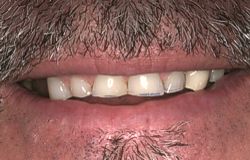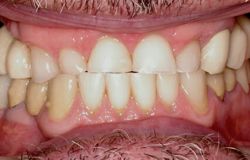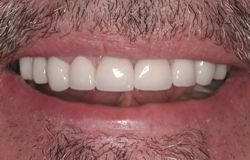Collapsed Bite Makeover
Dynamics of Bite Collapse
Normal wear and tear on our teeth will eventually cause closing of the bite. An extreme example would be the traditional "granny bite" we associate with grandparents where the lips seem to cave in or pucker.
 Since the average person has some form of restorative dentistry performed throughout the years, the physical properties of crowns, bridges, fillings, and onlays will accelerate the process and cause uneven wear across different tooth structures.
Since the average person has some form of restorative dentistry performed throughout the years, the physical properties of crowns, bridges, fillings, and onlays will accelerate the process and cause uneven wear across different tooth structures.
Our featured patient, a sixty something male, had the traditional signs of a collapsing smile. The wear and tear can easily be seen on the anterior teeth. They have become severely shortened. Notice how the patient's other natural teeth have similar loss in height. The discolored tooth structure in the upper arch is a crown and does not show the same amount of wear (porcelain wears differently).
 Patients who are nighttime teeth grinders, daytime teeth clenchers, and have not been treated for bruxism have wear and tear issues that can become severe at a relatively young age, as early as the late 20's or 30's. The physical forces upon certain tooth structures can become destructive if the biting surfaces are uneven. Bruxers often complain of tooth breakage.
Patients who are nighttime teeth grinders, daytime teeth clenchers, and have not been treated for bruxism have wear and tear issues that can become severe at a relatively young age, as early as the late 20's or 30's. The physical forces upon certain tooth structures can become destructive if the biting surfaces are uneven. Bruxers often complain of tooth breakage.
Left untreated, a collapsing bite can become worse and destructive in a short amount of time, depending on the characteristics of certain tooth structures
Smile Behavior
As bites collapse, the ability to smile becomes more difficult. Typically, the upper lip does not move the way it did when the upper arch had natural height. As the bite slowly closes down, the upper lip reveals less of the upper teeth and may, for many patients, show more of the lower teeth. Efforts to force a normal smile may produce an odd appearance.
Bite Normalization
 Most patients know something is missing when they have lost the ability to smile the way they did when bite characteristics were normal. Our patient had these issues, along with some periodontal problems that most adult patients are faced with.
Most patients know something is missing when they have lost the ability to smile the way they did when bite characteristics were normal. Our patient had these issues, along with some periodontal problems that most adult patients are faced with.
Our patient's change in bite required some attention for periodontal (gingivitis) gum disease issues and also orthodontic changes (alignment of certain tooth structures). A custom combination of 6 Nobel Biocare dental implants, two 3-Unit bridges, and a total of 12 IPS D.Sign porcelain crowns for creating the bridgework and restoring individual tooth structures were used to re-establish the occlusal bite that was best normalized for the patient.
A custom palatal expander was used as needed to shift occlusal surfaces into an optimal position that would assure proper alignment of the upper and lower jaws. Contrary to popular belief, upper jawbone structures can be altered in adults as they commonly are in pre-teen patients. Occlusal studies performed by Dr. Petulla provided the technical data needed for recreating the lost bite and occlusion properties the patient once had when his bite height (vertical dimension) was normal.
The technical analysis and ongoing monitoring provided by Dr. Petulla permitted the patient to focus on the cosmetic characteristics he wanted in his smile makeover, while the details of maintaining near perfect dental health would be assured. The functional and cosmetic outcome was quite dramatic, as seen in our last treatment photo.
